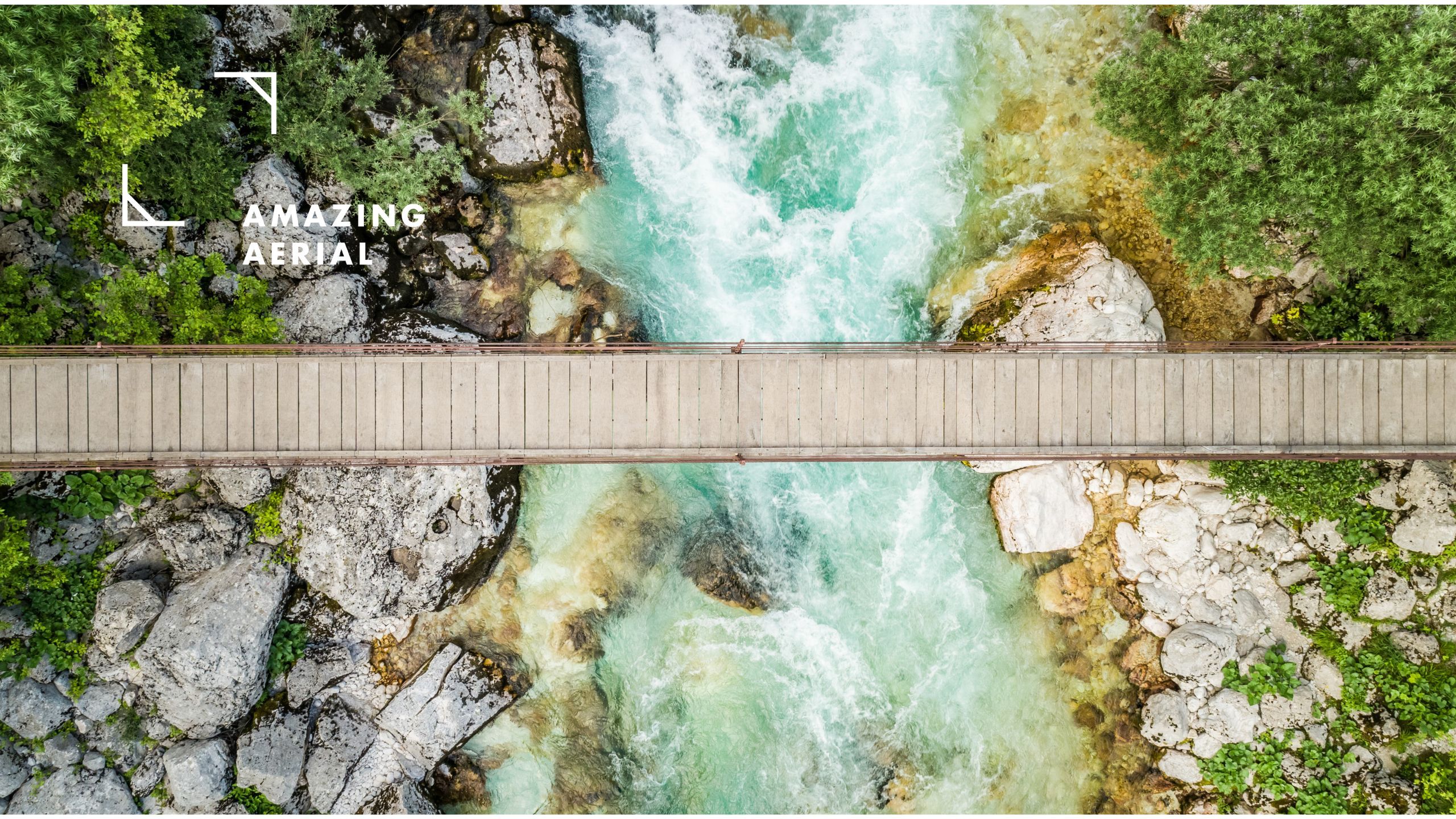Can Europe's Rivers Withstand Another Dry Winter?
After a historic drought in the summer of 2022, Europe experienced an uncharacteristically hot and dry winter. The falling water levels, visible even on drone photos, signal a difficult summer ahead.
Mar 10, 2023

The Soča River in Slovenia. The beautiful tumbling river was one of the rivers affected by the 2022 summer drought, affecting Slovenia’s hydroelectric supply. It is hardly the only river to suffer such a fate, and many will experience the same this upcoming summer. © Amazing Aerial Agency / Paul Prescott
 By Rebecca Duras
By Rebecca Duras
Winter in most of Europe usually means heavy coats, snowfall, and complaining about the cold. This year, many Europeans spent more time reaching for light jackets and hiking boots than parkas and skis due to very warm, sunny weather.
As beautiful as a sunny day can be, the unseasonably warm weather will have long-term implications for Europe’s water supply, as many of Europe’s rivers, lakes, and other bodies of water are at record-low levels. Europe’s water supply still hasn’t recovered from record droughts in the summer of 2022. Many environmental NGOs are trying to raise the alarm. So are drone photographers, whose photos capture the drastically different appearance of Europe's rivers and lakes compared to a few years ago.
According to the European Drought Observatory, many parts of Europe, including northern Italy, central France, the Spanish coast, and parts of the Balkans are facing a rainfall and soil moisture deficit—in winter. The prognosis for the summer ahead feels even dryer. Environmental organizations are hoping that their work in tandem with other media such as aerial photography can raise awareness about what lies ahead.
How Europe’s Rivers Continued Shrinking
“The droughts will become more and more a reality,” Ulrich Eichelmann, the founder and CEO of River Watch exclaims while in conversation with Amazing Aerial. “The question is not whether there will be droughts, the question is how we deal with it.”
Disruption to Europe’s normal weather patterns has long been a reality. As Ivana Korn-Varga and Ljubiša Mijačić of WWF-Adria explain when Amazing Aerial asks them about the situation in the Balkans, “The amount of precipitation has on average stayed the same, but the frequencies are periodically rarer but with larger quantities [...] often taking the form of natural disasters.”
Many did not take notice until the dramatic events of last year. Swathes of Europe experienced a historic drought in the spring and summer of 2022. Analysts found that the drought was the worst on the continent in the past 500 years.
When the long, hot summer ended, many in Europe breathed a sigh of relief. Winter, when temperatures plummet and precipitation increases, is when water reserves in most of Europe historically replenish themselves. This year, a wet, cold winter was more important than ever for Europe’s drought-ravaged water supplies.

A dusting of snow on Mount Terminio, Italy. Most of Europe’s mountains, including the famous Alps, only received a little snowfall this winter, affecting the continent’s water supply. © Amazing Aerial Agency / Michele Rinaldi
Unfortunately, the opposite happened. Across Europe, this winter has been historically dry and warm. For example, France experienced a record 31 days in a row without significant precipitation, leading some regions to already declare a drought warning.
The lack of snow in much of Europe’s mountains, including the Alps, has worrying implications for the year ahead. Many of Europe’s most important freshwater sources, such as the Rhine River, replenish themselves from melting glaciers and snowmelt. If there is no snow, then the water levels come early spring will already be much lower than in previous seasons.
As Eichelmann explains, low rainfall just exposes a problem with the past several decades of European water management that are responsible for low water levels in rivers, lakes, and reservoirs. “Our water management was following the principle of getting rid of the water,” he explains, using techniques such as straightening river channels, draining wetlands, and redirecting water for hydropower and agricultural use. That makes Europe’s water management systems unprepared for dealing with the problem of retaining water instead of channeling excess water away.
The team from WWF-Adria, which works on the UNESCO Mura-Drava- Dunav Transboundary Biosphere Reserve, an important wetlands system shared by five European countries, emphasizes that falling water levels are a multi-year problem, even though the drought just starting making news last year. “The intensification of drought which we’ve noticed over the past two decades has a strong, palpable effect,” they explain, more than just one dry winter. Locals are already noticing lower groundwater levels, lower water levels in the rivers, and slow forest growth.
A Dry Year Ahead
According to Amazing Aerial photographer Frederic Ducout, the Loire sailors are worried about the changes to the rivers they observe. Ducout, who was born on a barge himself and is intimately familiar with life on the water, said, “the sailors of the river told us that due to this lack of rain there is no more flooding,” exposing features such as sandbanks. His drone photos of the Loire in autumn juxtapose two sights that rarely appear at the same time: exposed sandbanks and changing fall foliage.
The sailors are not alone. Farmers, environmentalists, and others are already nervously eyeing the weather forecast for the year ahead, even though drought usually isn’t something people worry about in the winter. In Switzerland, forest fire alerts are already in place due to historic dryness. Looking at rivers in the Balkans, WWF-Adria explains, “considering that there practically was no winter in the Balkans this year, it’s hard to expect that we will have a better situation in terms of the water levels than we did last year.”
Many of the affected areas already struggling with drought, especially the Po River Valley in northern Italy, are some of Europe’s most important agricultural areas. If there is no water for irrigation, then food supplies will suffer. Eichelmann shares with Amazing Aerial that he is worried that farmers will turn to technical solutions, such as drilling deeper to access groundwater, which will further tax the unified water systems of Europe.
Low water levels also herald challenges to Europe’s energy supplies. During the previous drought, low water supplies in rivers shut down hydroelectric power plants. According to statistics River Watch shares with the magazine, experts estimate that by 2040 or 2050, hydropower electrical production will go down by 20%, and the decrease is already happening. The statistic undermines the ongoing attempts by investors to build more hydroelectric dams, which are present on many European rivers and affect the integrity of the water supply. “Hydropower plants divert the water leaving the actual river water with so-called residual flow that is minimal,” Eichelmann explains. “The water is so warm because it is so shallow, so hardly any organisms live there.”
Some, especially those living around the Po, are placing their hopes in spring rainfalls as that is historically the wettest season in the region. Others are less optimistic. They see this dry winter, following a historic hot and dry summer, as a sign that climate change is coming for Europe’s water supplies faster than most people think. For Ulrich Eichelmann, neither waiting or hoping is the solution. Authorities need to work on rewilding Europe’s rivers, stopping more dam projects, and letting nature be nature. “This we can do very quickly, while fighting global warming is a mid-term or long-term perspective,” he adds.
How An Aerial Perspective Can Help Europeans Come to Grasp with a New Reality
Photography, especially aerial photography, can provide a unique perspective that drives home the reality of what is happening in Europe and beyond.
Photography is an important record of changes to the landscape around us. As Amazing Aerial team member Armand Sarlangue put it in a previous interview, “We love nature, and it can be very painful to see some locations we love being impacted…we can see the impact sometimes over 2-3 years.”
Photographs help drive home the importance of what is happening to the public, for whom statistics about rain may not mean much. A photo of a location from a few years ago, side by side with a photograph for today, can show how drastically the situation changed in just a few years. There’s a reason why over the summer, many journalists and eco activists resorted to sharing dramatic photos of dried-out river beds on social media.
“Drone footage is extremely valuable because it gives you a different perspective,” Eichelmann explains. Advocacy groups like River Watch need photos that capture both the character of the rivers as well as the threats they are facing, photos of beauty and ugliness. Aerial photography makes it easier to show the scale of destruction projects such as dam construction can cause. Both WWF-Adria and River Watch emphasize the importance of rewilding, which is easier to advocate when there are photographs showing exactly how human intervention is affecting bodies of water.
Aerial photography of Europe’s rivers and other bodies of water will be valuable to bring home the reality of the situation as they shift in response to the drought which looks like it will be a feature of European seasons instead of a one-off event. For many years, Europeans and their policy makers thought that problems with water supplies would be restricted to sub-Saharan Africa or other far-away places. Now, the reality of climate change is coming home, faster than most Europeans expected. And it is far more dangerous than no snow on the Alps.
Stay updated when we post new articles.
We hate SPAM. We will never sell your information, for any reason.










